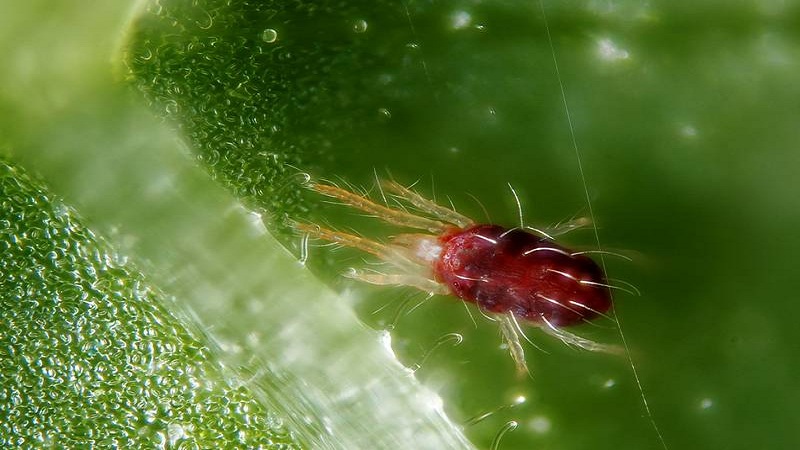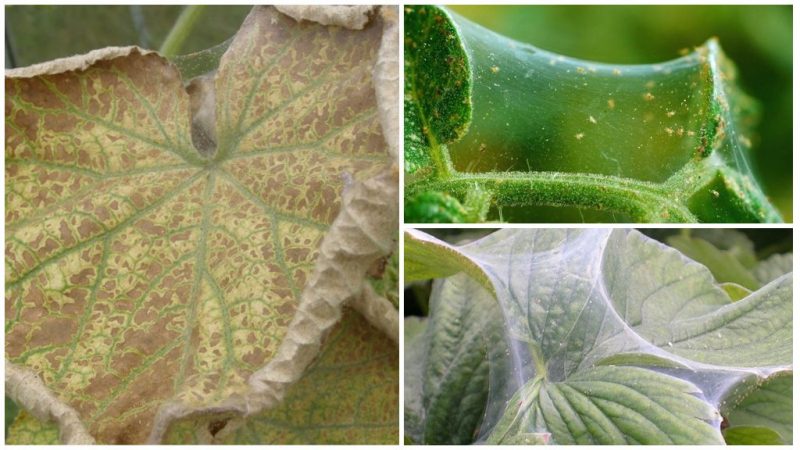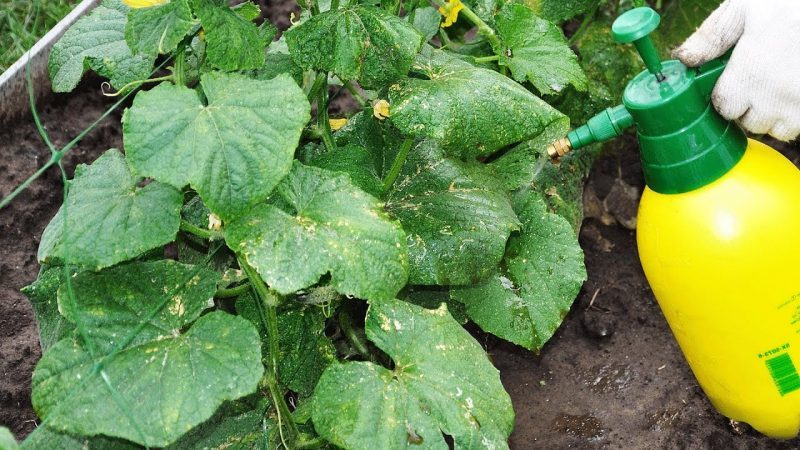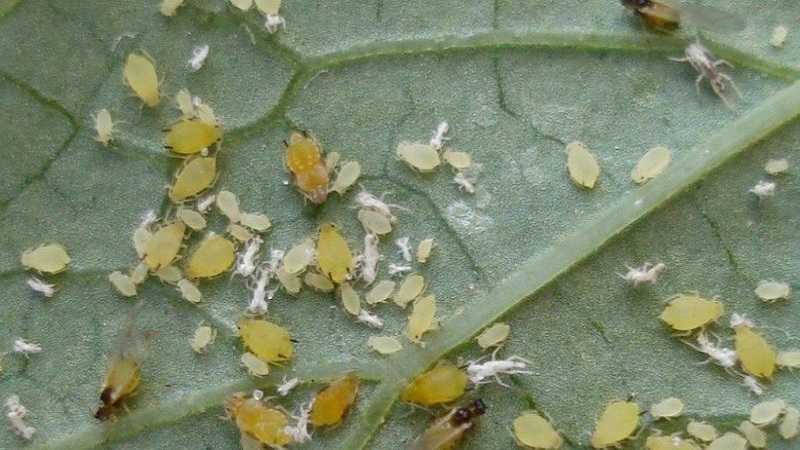How to get rid of spider mites on cucumbers in a greenhouse: proven methods of control and prevention
Spider mite is a dangerous pest that affects cucumbers in the garden and greenhouse. Small colonies grow with great speed and completely take over the plantings. Already seven days after the appearance of a spider mite on the site, it can be found by traces of life on the greenery. Then a cobweb appears on the leaves, in which colonies of insects are located.
In this material, we will take a closer look at the basic methods of dealing with spider mites on cucumbers in a greenhouse. Let's talk about effective insecticides, biological preparations, folk remedies and the frequency of use. You will learn how to prevent infestation of cucumbers in an enclosed space using agricultural techniques.
The content of the article
Description of the pest
The spider mite (Tetranychinae) is a polyphagous pest that feeds on plants in both indoor and outdoor fields. The greatest harm is caused to plantings in greenhouses. The confined space creates ideal conditions for increasing the arachnid population.
The small size of the tick, only 1 mm, does not allow for immediate recognition. Colonies can only be found by examining the back of the leaves with a strong magnifying glass.
The color of the body is red, green-yellow, orange, milky-transparent. Hibernating females are large, red or red. Males have a more elongated body. Some individuals, with enhanced nutrition, reach a size of 2 mm.
Soft-bodied spiders have an ellipsoid shape, the upper part of the body is convex, the lower one is aligned, more flat. The larvae are transparent, light green or green-brown in color with dark spots on the sides. Adults have four pairs of legs.
Females are fertile and lay up to 500 eggs every 3-4 hours. The eggs are round in shape, immediately after laying - white-yellow or milky-transparent. During the year, individuals go through up to 12 development cycles. Fertilized eggs hatch females, unfertilized eggs hatch males.
The rate of development of embryos depends on the air temperature in the greenhouse: at + 15 ° С - 15 days, at + 30 ° С - 48-72 hours. The total life span directly depends on temperature indicators and varies from 2 to 8 days. This feature is taken into account during plant treatments.
With the onset of cold weather, nymphs (pupae) leave for the winter in the form of non-feeding females. Some of them move from bushes to other places for wintering. Some seek refuge below, others take refuge in the upper part of the greenhouse. Therefore, the treatment of plants, unfortunately, does not guarantee the complete destruction of the pest.

The reasons
The main reason the appearance of ticks on cucumber plantings in the greenhouse - heat and low air humidity. The pest feels comfortable at a temperature of + 30 ° C and above. Most often found in the southern regions when growing cucumbers on the balcony.
Arachnids reproduce most actively on fattening plants (gaining green mass to the detriment of fruits). Fatting occurs for a number of reasons, but most often when there is an excess of nitrogen in the soil.
The pest settles in the dried remains of plants that have not been removed from the site. From them, he moves to the cucumber bushes. In spring, when the air temperature rises to + 10 ° C, females begin to actively lay eggs on the back of the leaves.
At first, the pest occupies the upper leaves, then moves to the lower part of the bushes.Gardeners often do not pay attention to the lower leaves. But it is they who become the main breeding ground for the spider mite.
It is interesting:
Why are tomatoes in the greenhouse fattening and what to do if this happens.
Signs of appearance

The main food of the pest is plant cells. The main sign of its presence is small white dots on the back of the leaves.... A little later, a thin cobweb appears, like a veil entwining bushes.
With severe damage, the leaves turn white from multiple injuries. On the tips of leaves and shoots, you can see hordes of small, moving pests.
As a result of cell destruction, the process of photosynthesis is disrupted. The plant weakens, immunity decreases. Against this background, secondary diseases of cucumbers join. Ticks are the main carriers of gray mold spores.
Control measures for spider mites on cucumbers in the greenhouse
How to get rid of a pest in an enclosed space? For control and treatment, chemical, biological preparations, folk remedies, predatory mites (Ambliseius and Fitoseyulus) are used. Preventive measures are no less effective.
Chemicals

Chemicals are classified as "heavy artillery". They are used in cases where other methods have not helped. The insecticide quickly cope with the pest, but have a toxic effect on the environment and humans.
The main disadvantage of such spraying is that insects quickly develop resistance. Therefore, it is advisable to change the formulations every 2-3 sprays.
It is important to remember that one processing of cucumbers is not enough to completely get rid of insects.
The intervals between irrigation of the bushes depend on the weather. The higher the temperature and drier the air, the more often the treatments are carried out. In summer, spraying is repeated every seven days. This is how much time the female needs to develop and lay eggs.
Spraying is carried out in the evening, since the scorching sun promotes rapid evaporation of substances.
| Name | Description | Protection period | Processing frequency |
| "Plant-pin" | The active ingredient is butoxycarboxyme. The drug is released in sticks, which are immersed in the ground, near the bushes. | 1.5 months | 1 |
| "Etisso" | The active ingredient is dimethoate. Nourishes plants and protects against insects. Produced in the form of sticks. | 3 months | 1 |
| Apollo | Sterilizes adults, preventing development. The larvae and eggs are completely destroyed. It has a contact-intestinal action. |
30 days | 2 |
| "Karbofos" | The active ingredient is malathion. Insectoacaricide destroys adults when directly hit. | 7 days | 2 |
| "Vertimek" | The active ingredient is abamectin. Means with contact and intestinal action. | 1 month | 2 |
| Flumite | Contact and intestinal agent with diflovidazine. Destroys winter egg clutches. | 30 days | 1 |
| "Actellik" | The active ingredient is pirimifosmethyl. Suspension with a high hazard class. The best drug for spider mites. | 10-12 days | 2 |
| "Neoron" | Contact-intestinal insecticide with bromopropylate. Destroys ticks by thoroughly spraying bushes from all sides. | 10 - 40 days | 1 |
| "Nissoran" | Contact and intestinal remedy for nymphs and tick larvae, with hexythiazox. The hazard class for bees and people is low. | 1.5 months | 1 |
| "Omite" | Contact agent with propargite. Acts on adults, nymphs and larvae, except for eggs. | 2 weeks | 2 |
| "Ortus" | Contact insecticide paralyzing action. The active substance is fenpiroximate. Can be combined with pesticides. The active substance is propargite. | 15 days | 2 |
| "Sunmight" | The contact agent fights the tick at all stages of its development. Has a paralyzing effect. The active substance is pyridaben. | 1.5 months | 1 |
Important! When working with Aktellik, safety measures are observed. For protection, use a dressing gown, rubber gloves, a mask, glasses.
Biological methods and preparations

Biological agents affect only adults. Therefore, spraying is carried out 3-4 times every week.
The list contains the most environmentally friendly and effective preparations against spider mites that are allowed for use during the period of active fruiting:
- "Akarin" - an enteric contact preparation with avertin as an active substance. The period of exposure to the tick is 8-16 hours.
- "Aktofit", "Kleschegon", "Kleschevit", "Fitoverm" with one active ingredient - aversectin. The neurotoxin enters the insect's body and paralyzes the nervous system. The drug is not addictive, unlike chemical insecticides.
- "Bitoxibacillin" - biological insecticide, contains Bacillus thuringiensis var. thuringiensis. Processing is carried out during the growing season twice a month. The agent does not accumulate in the green mass and fruits.
Reference. High efficiency is shown by treatment with a mixture of "Aktofit" and "Bitoxibacillin".
When growing cucumbers in greenhouses, mites are used for control - Ambliseius and Fitoseiulus. These are the natural enemies of the pest. You can buy them at flower shops.
When used correctly, predatory insects can kill up to 95% of pests. Two weeks before planting cucumbers in the greenhouse, they release in bulk about 50 amblyisei per 1 m². The life span of an insect is 20-25 days.
The predatory mite phytoseiulus (Phytoseiulus persimilis) is distinguished by its rapid reproduction and gluttony... The efficiency of the arachnid increases with high humidity and moderate temperatures in the greenhouse. With a slight lesion, 10-15 phytoseiulus are released per 1 m², and with an extensive lesion, 30-40 individuals are released, closer to the focus of infection.
Plants that repel spider mites

Plants are planted in the greenhouse next to the planting of cucumbers to repel the pest. The method is used in combination with treatments with biological, chemical preparations and folk remedies. Such plants cannot cope with the task on their own.
The most effective are: calendula, marigolds, wormwood, parsley, mint, garlic, onions, yarrow, cyclamen.
Reference. Moss or bark is used to scare away spider mites. Raw materials are treated with boiling water for disinfection and dried. Then they are buried in the ground under the bushes.
Folk remedies
Folk remedies based on herbs help repel pests, but are not able to completely destroy it. They begin to fight folk remedies during the period of active fruiting of cucumbers, when acaricides are prohibited.
Spraying is carried out on the back of the leaves. It is there that the pest is hiding.
| Name | Preparation and application |
| Marigold | Fill a bucket halfway with dried flowers and cover with warm water. Insist for two days, strain and mix in 50 g of shavings of laundry soap. Treat bushes in dry evenings once a week. |
| Potato tops | Fill a bucket halfway with herbs and cover with warm water. After 5 hours, strain and process the plantings. Use once a week. |
| Tomato tops | Fill a 10-liter bucket halfway with tops and fill with water. Boil over low heat for 30 minutes, cool and add 40 g of grated tar soap. Dilute the concentrate with water 1: 2 and spray the bushes once a week. |
| Aconite nose | Prepare an alcohol solution from the roots, leaves or tubers of the plant. Dissolve 100 ml of the product in 1 liter of water and spray the plants once every 7 days. |
| Dandelion roots | Pour 30 g of chopped dry roots with 1 liter of water and leave for 2-4 hours. Irrigate the bushes twice a week. |
| Hogweed | Plant roots, collected before or after flowering, dry and fill with water (for 1 kg of raw materials - 10 liters). After 24 hours, the product is ready for use. |
| Garlic | Chop two heads of garlic and pour 1 liter of warm water. Insist 5 days, strain before use and dilute with water 1: 2. |
| Datura ordinary | Pour 100 g of dry raw materials with 1 liter of water. After 12 hours, strain and apply to irrigate the leaves. |
| Onion peel | Pour a few handfuls of husks with 1 liter of water. Insist for five days, and dilute with water 1: 2. |
| Creeping gorchak | Pour 100 g of dry raw materials with 1 liter of water, leave for 10 hours. Dilute 1: 2 with water before use. |
Agrotechnical techniques for the prevention of infection

Correct cultivation of cucumbers is also effective in combating the pest:
- frequent weeding and loosening of the soil;
- moderate watering;
- timely introduction of potassium-phosphorus dressings;
- control of nitrogen levels in the soil;
- removal of plant residues;
- keeping the distance when planting (sowing);
- crop rotation;
- disinfection of greenhouses with sulfur checkers;
- soil treatment with a 0.5% solution of copper sulfate (50 g per 10 l);
- control of the humidity level (optimally above 80%);
- air temperature control (+ 25-27 ° С);
- selection of spider mite-resistant cucumbers;
- removal of the top layer of soil (15-20 cm) and replacement with a new one.
Spider mite resistant varieties
Varieties and hybrids with hard fibrous leaves are the most resistant to tick infestation. They do not have complete protection against spider mites, but biologists are working hard in this direction.
| Ripening period | Pollination type | Length | Taste | Productivity 1 m² | |
| 5 stars | 40-42 days | Parthenocarpic | 10 cm | Refreshing without bitterness | 15-16 kg |
| Fontanel f1 | 50-55 days | Bee-pollinated | 9-12 cm | 17-25 kg | |
| Goosebump
f1 |
43-46 days | Parthenocarpic | 11-13 cm | Pleasant, no bitterness | 10-12 kg |
| Benefit f1 | 45-50 days | Parthenocarpic | 12 cm | Sweetish, without bitterness | 15-17 kg |
Read also:
How to deal with spider mites on pepper seedlings.
What is the danger of spider mites on eggplants and how to deal with them.
Conclusion
To quickly get rid of the putin mite on cucumbers, the greenhouse uses chemicals that destroy the pest at all stages of development. It is customary to alternate preparations, since pests quickly develop resistance.
Biological agents for treatment make it possible to obtain environmentally friendly products, but only affect adults. Predatory mites (Ambliseius and Fitoseiulus) do an excellent job and destroy spider mites by 95% in the greenhouse.
Folk remedies are used to repel pests. Preventive measures are effective before planting seedlings, they prevent the spread of the tick.
I have marigolds and calendula growing everywhere. This year they put up a greenhouse, the flowers that were the first to grow there! spider mites caught the eye. I had to rip out the flowers, so it's hard to believe that the ticks bypass them.
And the cucumber Spring F1, by the way, is also in a spider mite.